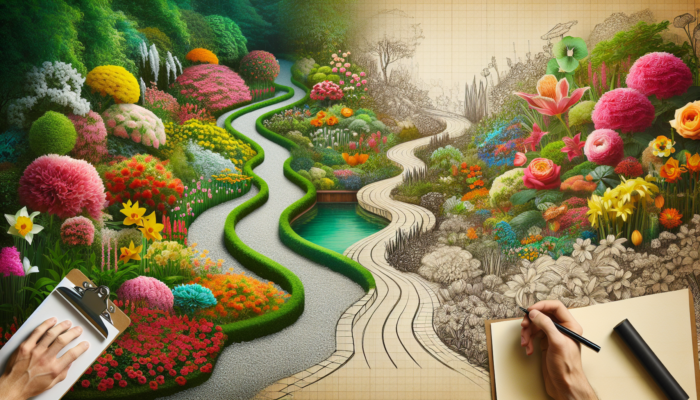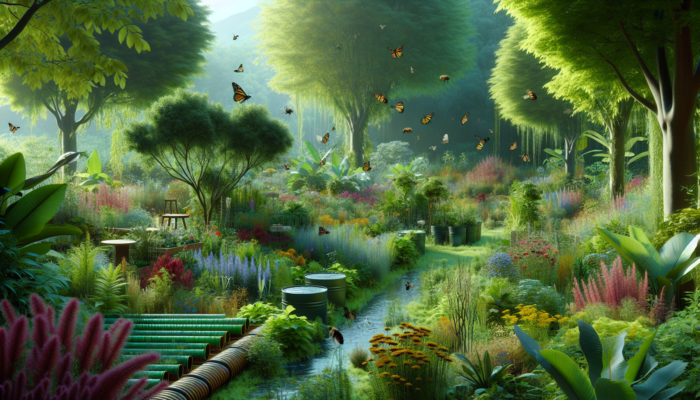Transform Your Life by Cultivating a Garden: Unlock the Therapeutic Benefits of Nature
The significance of a garden in our daily lives is truly remarkable. In an era characterised by relentless pace and overwhelming stress, a garden serves as a serene sanctuary where individuals can reconnect with the natural world and revitalise their spirits. The essence of green living is beautifully encapsulated in how a garden not only beautifies our immediate environment but also plays a vital role in enhancing both our physical and mental well-being. By tending to our personal green spaces, we nurture a holistic lifestyle that promotes peace, inspires creativity, and strengthens our bond with the natural world.
Discover the Therapeutic Advantages of Gardens: Elevate Your Well-Being and Encourage Relaxation

A garden transcends the mere assembly of flora; it represents a peaceful retreat that significantly bolsters our overall well-being. Numerous studies have indicated that spending time in natural surroundings, particularly within a garden, is highly effective for lowering stress levels and enhancing mood. Engaging in gardening activities offers therapeutic benefits as they encourage mindfulness and presence, which in turn soothe the mind and clarify our thoughts, laying the foundation for emotional stability.
Participating in a garden—whether it involves planting colourful flowers or harvesting fresh produce—promotes physical activity, which is essential for improving fitness levels. The tactile experience of connecting with the earth and observing the growth of plants fosters a profound sense of achievement and satisfaction. These enriching pursuits have a positive effect on our mental health, alleviating anxiety and depression while encouraging a balanced emotional state.
Furthermore, a garden can serve as a lively social hub where family and friends gather. Participating in shared outdoor activities strengthens social ties and nurtures community spirit. An artfully designed garden invites people to enjoy the outdoors, be it through barbecuing, engaging in games, or simply relaxing with a captivating book. Ultimately, the garden transforms into a vibrant backdrop for creating cherished memories and fostering meaningful relationships.
Enhance Your Quality of Life: Uncover the Transformative Benefits of a Garden
The quality of life is influenced by a myriad of factors, and the role of a garden is pivotal in maintaining this delicate balance. A thoughtfully designed and well-tended garden not only beautifies the surrounding environment but also profoundly transforms the lifestyles of those who inhabit it, contributing to overall happiness and satisfaction.
Primarily, the ability to harvest fresh fruits and vegetables from your very own garden significantly boosts overall well-being while concurrently improving dietary habits. Homegrown produce is not only more flavourful but also packed with essential nutrients since it can be enjoyed immediately after harvest. This intimate connection to food and the cultivation process fosters a greater awareness of healthy eating and sustainable practices, ultimately leading to improved health outcomes.
Moreover, a garden plays a critical role in improving air quality. Plants naturally purify the air, filtering pollutants and producing oxygen, thereby contributing to a healthier living environment. In urban settings where air pollution poses significant challenges, gardens act as essential green lungs, cleansing and refreshing the surrounding atmosphere, enhancing the quality of life for all inhabitants.
Additionally, a garden functions as a canvas for personal expression. Whether experimenting with various plant species, designing landscapes, or mastering innovative gardening techniques, a garden encourages creativity and self-actualisation. It becomes a reflection of one’s personality and values, enriching the overall quality of life and providing a sense of purpose and achievement.
Integrating Gardens into Modern Architectural Designs: A Groundbreaking Approach
In contemporary architectural design, the garden is increasingly acknowledged as an essential element of both residential and commercial spaces. The significance of gardens within architectural frameworks extends far beyond mere aesthetic appeal; they are vital for enhancing quality of life and fostering ecological sustainability.
Modern architectural concepts often incorporate vertical gardens and rooftop gardens as integral design features. These innovative solutions not only optimise available space but also promote biodiversity in urban environments. Vertical gardens can transform wall surfaces into lush green sanctuaries, creating visually stunning landscapes while providing insulation, leading to reduced energy consumption and enhanced environmental benefits.
Furthermore, the integration of gardens is becoming more prevalent in the design of residential complexes. Community gardens and thoughtfully landscaped areas that encourage social interaction are frequently integrated into modern housing developments. These gardens provide residents with opportunities to connect, share experiences, and enjoy quality time outdoors, effectively enhancing community cohesion.
In essence, a garden is not merely a luxury in modern architecture; it has evolved into a necessity. It contributes to improved quality of life, promotes health, and plays a crucial role in addressing environmental challenges in urban settings, proving that nature and modern living can coexist harmoniously.
Realising Your Dream Garden: From Concept to Creation

Designing a garden necessitates a harmonious blend of creativity and strategic planning. From the initial concept to the final execution, there are numerous factors to consider in order to create a cohesive and functional outdoor space that meets your needs.
Key Steps to Launch Your Garden Planning Journey
The journey toward planning a garden begins with a clear vision. What objectives do you have in mind? Do you dream of a tranquil retreat, a playful space for children, or a flourishing vegetable garden? The initial steps in garden planning should be firmly rooted in your unique aspirations and requirements, providing a strong foundation for your design.
Moreover, it is essential to evaluate the existing conditions of your space. Factors such as light exposure, soil quality, and topography should all influence your planning decisions. A location with excessive shade may not be suitable for sun-loving plants, while an area that receives too much sunlight might not support shade-loving varieties effectively.
Another critical aspect of planning your garden involves selecting an appropriate design style. Do you prefer a formal garden characterised by clean lines and symmetry, or do you gravitate towards a more natural, informal aesthetic? Your design choice will significantly influence the overall experience you wish to create, shaping the atmosphere and functionality of your outdoor space.
Essential Considerations for Selecting the Ideal Plants for Your Garden
Choosing the right plants is crucial for the success of your garden. Several factors must be assessed to ensure that the plants thrive and harmoniously coexist.
Firstly, consider the climate of your region. Plants that flourish in one area may struggle in another. It’s vital to pay attention to USDA plant hardiness zones to select species that are suited to your specific environment, ensuring optimal growth conditions.
In addition to climate considerations, soil quality should be a top priority. Some plants thrive in well-drained soil, while others prefer denser, moisture-retentive soils. Conducting a soil analysis can help identify nutrient levels and pH values, maximising your plant selection and ensuring successful growth.
Another important aspect is the timing of flowering. To maintain year-round visual appeal, opt for plants with varying blooming periods and colours. A thoughtful blend of evergreen plants, spring bloomers, and autumn foliage will create a dynamic and vibrant garden that captivates the senses throughout the seasons.
Creating a Sustainable Garden: Strategies for Eco-Friendly Gardening

Establishing a sustainable garden is not only beneficial for the environment but also serves as a cost-effective approach to gardening. Sustainability within the garden involves conserving natural resources and promoting biodiversity.
A vital first step is selecting native plants. These species are often better adapted to local conditions, require less water, and tend to be less susceptible to pests. Native plants also support local wildlife by providing essential habitats for pollinators such as bees and butterflies, reinforcing the ecosystem.
Utilising rainwater is another key component of a sustainable garden. By collecting rainwater, you can effectively support your garden’s water supply while decreasing reliance on municipal sources, thus conserving water resources.
Lastly, integrating composting into your gardening practices is crucial. Recycling organic waste to create compost enhances soil quality while minimising waste. This compost serves as a rich source of nutrients that promotes healthy plant growth while reducing the need for chemical fertilisers, leading to a more sustainable gardening approach.
Garden Upkeep: Effective Strategies for Maintaining a Flourishing Outdoor Oasis
Maintaining a garden is an ongoing commitment that demands patience and dedication. However, with the right strategies and techniques, any garden can thrive and blossom into a stunning paradise.
Fundamentals of Plant Care for Optimal Growth and Health
The cornerstone of successful garden maintenance lies in appropriate watering, fertilisation, and overall plant care. Regular watering is critical, particularly during the growing season. It’s essential not only to provide moisture to the plants but also to ensure that water penetrates deeply into the soil, encouraging robust root development.
Additionally, fertilisation plays a vital role in supporting plant health. Opting for organic fertilisers can enhance soil fertility and stimulate vigorous plant growth. Be mindful to adjust fertiliser types according to the specific requirements of various plant species to optimise their growth potential.
Weed control is another key aspect of garden maintenance. Weeds compete for essential nutrients and water, undermining your plants’ growth. Regularly weeding and applying mulch are effective methods to keep weeds at bay while preserving soil moisture, thus ensuring a healthier garden.
Seasonal Garden Responsibilities: Ensuring Your Garden Thrives Year-Round
Garden maintenance encompasses not only daily tasks but also seasonal responsibilities that contribute to the health and beauty of your garden. In spring, it’s time to prepare the soil, plant new specimens, and divide perennials. Be sure to wait until after the last frost before introducing frost-sensitive plants outdoors.
During the summer months, concentrate on watering and pruning. Regular pruning encourages healthy growth and flowering while aiding in maintaining plant vitality. Additionally, mulching to retain moisture is essential during this warmer season to prevent dehydration.
As autumn approaches, it’s crucial to ready your garden for the colder months ahead. Remove dead plants and tidy up garden beds to prevent disease and pest issues. Adding compost or mulch can protect the soil during winter and prepare it for the upcoming growing season, ensuring a robust start come spring.
Natural Pest Control Techniques: Keeping Your Garden Healthy and Eco-Friendly
Managing pests in the garden doesn’t always require chemical interventions. Numerous natural methods are both effective and environmentally friendly, ensuring a sustainable approach to pest management.
One of the simplest and most sustainable strategies is to foster beneficial insects that prey on pests. Insects such as ladybugs, hoverflies, and certain birds act as natural predators for many common garden pests. Planting flowers that attract these beneficial creatures can significantly reduce pest populations, promoting a healthier garden.
Another effective technique involves using natural sprays derived from plant extracts. Neem oil and soap sprays are examples of organic insecticides that can combat pests without harming the environment or beneficial organisms.
Finally, implementing preventive measures is crucial. Regular monitoring and encouraging healthy plants can help ensure that pest issues do not escalate. A robust garden is inherently less susceptible to infestations and diseases, ultimately leading to a more sustainable gardening experience.
Selecting the Ideal Garden Furniture: Merging Comfort and Style Outdoors
Choosing the appropriate garden furniture is essential for creating a comfortable and inviting outdoor retreat. Garden furniture should be both functional and aesthetically pleasing, enhancing the overall appeal of your garden while providing a space for relaxation and enjoyment.
Selecting Garden Furniture That Mirrors Your Individual Style
Your choice of garden furniture should embody your personal style and the atmosphere you aim to create. Consider whether you prefer a modern, minimalist aesthetic or a rustic, traditional vibe. Material selection is also significant: wood, metal, and plastic each offer distinct benefits and drawbacks.
Wooden furniture adds warmth and character to the garden, while metal options often provide a sleek, durable alternative. Plastic furniture is lightweight and low-maintenance but may be less durable in the long term. It’s also vital to consider the weather resistance of your furniture to ensure it withstands your climate’s demands, preserving its appearance and functionality.
Additionally, take ergonomics into account when selecting furniture. Comfortable chairs and tables are essential for enjoyable gatherings in the garden. Weather-resistant cushions can enhance comfort and encourage longer outdoor enjoyment, allowing you to fully appreciate your outdoor space.
Maintaining Your Garden Furniture: Tips for Longevity and Care
To prolong the lifespan of your garden furniture, regular maintenance is essential. Wooden pieces should be treated with special oils to protect them from environmental damage and wear. Metal furniture may rust if not properly cared for, so routine cleaning and applying rust protection are advisable to maintain its integrity.
Plastic furniture is generally easy to maintain but still requires regular cleaning to prevent dirt and algae accumulation. Utilising specific cleaning agents can help preserve colours and surfaces, ensuring your garden furniture looks its best.
If the furniture isn’t used during winter months, it’s wise to cover or store it to safeguard against extreme weather conditions. This proactive approach ensures your garden furniture remains in excellent condition for years to come, allowing you to enjoy your outdoor space season after season.
Current Trends in Garden Furniture Design: What’s In and What’s Out
The landscape of garden furniture is continually evolving, with new trends enhancing outdoor spaces and catering to contemporary preferences. Sustainability is on the rise, with many manufacturers offering furniture crafted from recycled materials or sustainably sourced products. These options are not only eco-friendly but also stylish, appealing to environmentally conscious consumers.
Another emerging trend is the integration of technology into garden furniture. Illuminated pieces and furniture with built-in charging ports for electronic devices are gaining popularity. These innovations allow you to utilise the garden as an extension of your living space, merging functionality with aesthetics.
Lastly, the movement towards modular design is gaining momentum. Modular furniture allows for rearrangement and expansion based on events or needs, offering flexibility and adaptability. This versatility is highly sought after in modern gardens, making it easier to accommodate gatherings or personal preferences.
Creating Captivating Outdoor Spaces: The Significance of Garden Lighting
The right garden lighting can dramatically elevate the ambiance of your outdoor environment. It not only ensures safety but also highlights the beauty of your garden, transforming it into an inviting space even after dusk.
Understanding Different Types of Garden Lighting and Their Applications
Various types of garden lighting fulfil distinct purposes. Pathway lighting ensures safety and guides visitors through the garden. These fixtures can be solar-powered or electric and come in a multitude of designs to seamlessly integrate with the landscape.
Accent lighting directs attention to specific plants or areas, creating visual focal points. Spotlights can illuminate trees, sculptures, or unique plants, enhancing the overall atmosphere of your space and making it more engaging.
Ambient lighting offers gentle illumination, brightening the entire garden. This type of lighting is ideal for creating a warm and welcoming atmosphere without being overpowering. Popular options for achieving this effect include string lights and LED strips, which add charm and character to your outdoor setting.
Energy-Efficient Lighting Solutions: Eco-Friendly Choices for Your Garden
With rising energy costs, opting for energy-efficient garden lighting is becoming increasingly important. LED fixtures are widely recognised as the best option, consuming significantly less energy and lasting much longer than traditional bulbs, making them a sustainable choice.
Additionally, solar-powered lights represent an excellent option for the garden. They harness solar energy during the day and illuminate brightly at night, reducing energy expenses while providing an eco-friendly solution that contributes to sustainability.
Smart lighting systems that can be controlled via smartphones offer another efficient choice. They allow for adjustments in brightness and colour, enabling you to customise the atmosphere of your garden to suit your preferences and needs, enhancing your outdoor experience.
Safety Considerations in Garden Lighting: Ensuring a Secure Environment
The role of garden lighting in promoting safety cannot be understated. A well-lit garden minimises potential hazards and reduces the risk of accidents. It’s crucial to adequately illuminate pathways and entrances to prevent tripping and ensure the safety of all visitors.
Moreover, effective lighting can deter unwanted visitors. Motion sensors are a smart addition, activating lights only when someone enters the garden. This feature enhances security while conserving energy, providing peace of mind as well as practicality.
Another safety aspect to consider is using weatherproof and durable materials for garden lighting. Ensure that the chosen fixtures are suitable for outdoor use, capable of withstanding harsh weather without suffering damage, ensuring longevity and reliability.
Gardens as Playgrounds for Children: Encouraging Exploration and Learning
A garden provides children with a unique environment to explore and learn about the natural world. Designing a child-friendly garden can create a space where children can play and experiment safely, while gaining valuable insights into nature and developing a deeper connection with it.
Creating a Safe Garden Environment for Children
Safety should be the paramount concern when designing a garden for children. A secure garden must be free from sharp edges, toxic plants, and other potential hazards. Opt for robust, non-toxic plants that are safe for children to interact with, fostering an environment that encourages curiosity and play.
Another aspect to consider is creating play areas that are both safe and engaging. Incorporating sandboxes, play equipment, and grassy spaces provides ideal spots for children to engage in imaginative play and explore their surroundings.
Utilising natural materials for pathways and play areas can further enhance safety. Wooden or rubber surfaces are preferable to hard surfaces, which could lead to injuries, ensuring a safer play environment that promotes exploration and enjoyment.
Exciting Activities for Children in the Garden
A garden can serve as a vibrant playground for children, offering a plethora of activity opportunities that spark imagination. Gardening itself can be a fun and educational experience. Children can learn how to plant, nurture, and harvest various plants, instilling a sense of responsibility and accomplishment from a young age.
Additionally, creative projects such as building insect hotels or starting a small vegetable garden can inspire children to express their creativity while deepening their understanding of the environment and the importance of biodiversity.
Outdoor games such as treasure hunts or nature explorations stimulate children’s curiosity and eagerness to discover. Thus, a garden transforms into a space for exploration and learning, igniting their imagination and fostering a lifelong love for nature.
The Educational Benefits of Gardening for Children
Gardening imparts children not only with practical skills but also valuable educational content. Through the act of planting and caring for plants, children acquire essential life skills such as patience, responsibility, and teamwork, laying the groundwork for their personal development.
Moreover, interacting with nature helps children develop a better understanding of ecological relationships. They learn how plants grow, which insects are beneficial, and the critical importance of biodiversity in sustaining healthy ecosystems.
School projects that incorporate gardening can make learning about science, mathematics, and nutrition both practical and tangible. This hands-on approach not only enhances educational effectiveness but also makes learning more exciting and engaging for children, fostering a deeper connection with the subject matter.
Gardens and Environmental Stewardship: Advocating for Sustainability
The significance of a garden in promoting environmental health cannot be overstated. A well-designed garden can enhance biodiversity, conserve resources, and serve as a model for sustainable practices within the community, showcasing the potential of green spaces.
Enhancing Biodiversity Through Your Garden
A garden acts as a microhabitat capable of supporting a wide variety of plant and animal species. By opting for native plants, gardeners can help preserve local flora and fauna, ensuring that the ecosystem remains robust and diverse. These plants are often better adapted to regional conditions and provide food and habitat for countless beneficial insects and birds.
A diverse garden encourages pollination, which is vital for agriculture and food production. Creating habitats for pollinators like bees and butterflies is essential, not only for the health of your garden but also for the global ecosystem, contributing to food security and ecological balance.
Moreover, gardens can serve as sanctuaries for endangered species. By fostering biodiversity, gardens can help maintain ecological balance and ensure the survival of various species, reinforcing the importance of conservation efforts.
Composting and Recycling Practices in the Garden: Embracing Sustainable Approaches
Composting is one of the most effective methods for reducing waste while enhancing soil fertility. By recycling kitchen scraps and garden waste, gardeners can create valuable humus that enriches the soil and supports plant health.
Implementing compost bins or piles not only promotes waste reduction but also educates individuals about sustainable practices. Both children and adults can learn the significance of conserving resources and minimising waste, fostering a culture of sustainability within the community.
Additionally, utilising recycled materials, such as old pallets for raised beds or containers for planting, can help lessen your ecological footprint. These practices encourage creativity and sustainability in the garden, demonstrating that environmental responsibility can be integrated into everyday life.
Water Conservation Strategies for Sustainable Gardening
In an era where water scarcity is an increasing concern, employing water-saving techniques in the garden is crucial. Drip irrigation systems and rainwater harvesting setups are effective methods to conserve water while ensuring that plants remain healthy and hydrated.
Applying organic mulch helps retain moisture in the soil and minimises evaporation. This technique not only reduces water usage but also ensures that plants receive the hydration they need to thrive, promoting a sustainable approach to gardening.
Moreover, gardeners should opt for the right plant selections. Incorporating drought-resistant species can significantly lower water needs while still creating an aesthetically pleasing landscape, allowing for a beautiful garden without excessive resource consumption.
The Therapeutic Benefits of Gardening: Wellness Through Nature
The healing properties of nature have been recognised for centuries, and gardening therapy is gaining increased acknowledgment as a legitimate form of therapeutic practice. A garden serves not only as a source of joy but also as a sanctuary for healing and personal growth.
Exploring the Benefits of Gardening Therapy
Gardening therapy offers an array of benefits, encompassing both physical and psychological dimensions. Spending time outdoors has been shown to elevate mood and enhance overall wellness. Engaging in gardening activities can alleviate stress, reduce anxiety, and significantly improve quality of life, making it a holistic approach to health.
The physical activity associated with gardening contributes to better health outcomes. It promotes mobility, strengthens the cardiovascular system, and can even assist in rehabilitation after injuries, ensuring a comprehensive approach to wellness.
Furthermore, gardening therapy provides an outlet for creative expression and encourages mindfulness. Engaging with plants and soil can create a meditative effect, allowing individuals to immerse themselves in the present moment and clear their minds of distractions, fostering a sense of peace and tranquillity.
Implementing Gardening Therapy: Practical Approaches for Everyone
Implementing gardening therapy can take various forms. Community gardens present excellent opportunities to unite people while harnessing the healing benefits of nature. These gardens foster social interactions and create a sense of belonging, which is essential for mental health and wellness.
Individuals can also create their therapeutic gardens. Planting flowers, vegetables, or herbs can yield profound therapeutic effects, helping individuals connect with nature and assume responsibility for their well-being.
Therapists can strategically incorporate gardening therapy into their treatment plans by encouraging clients to engage in gardening activities. This approach can support both physical and mental health while promoting the healing journey, creating a more comprehensive model of care.
Research Validating the Effectiveness of Gardening Therapy
Numerous studies validate the benefits of gardening therapy across various settings. In mental health facilities, patients who participated in gardening therapy reported significant improvements in mood and overall well-being, demonstrating its potential as an effective therapeutic tool.
Moreover, programmes in schools have shown that students involved in gardening projects achieved enhanced academic performance and exhibited greater levels of self-esteem and social interaction. The connection to nature not only improves learning but also fosters emotional development, reinforcing the importance of integrating gardening into educational curricula.
Gardening therapy is also implemented in elder care, where it helps promote mobility and supports cognitive function. Engaging with plants and outdoor activities can greatly enhance quality of life while reducing feelings of isolation among seniors, contributing to healthier ageing.
Incorporating Technology into Your Garden: Modern Innovations for Effective Garden Care
Modern technology has made significant inroads into the realm of gardening, creating new opportunities to revolutionise garden design and maintenance. From smart irrigation systems to apps that assist in garden upkeep, the possibilities for enhancing your garden are virtually limitless.
The Benefits of Smart Garden Systems
Smart garden systems offer a plethora of advantages, including automated irrigation, fertilisation, and lighting. These systems enable precise control over environmental conditions in the garden, resulting in healthier plants and reduced water usage, making gardening more efficient and sustainable.
By utilising sensors, gardeners can access real-time data on soil moisture, temperature, and light levels. This information empowers informed decision-making and optimises garden care, ensuring that plants receive the right conditions for growth.
Moreover, smart garden systems can be managed via smartphones, making it convenient to oversee the garden from any location. This technology renders gardening more accessible and easier to maintain, encouraging more individuals to engage in this rewarding activity.
The Rise of Automated Garden Care: A Prominent Trend
Automating garden care is an emerging trend that saves time and effort. Robotic lawn mowers exemplify this technology, taking over lawn maintenance tasks and alleviating physical strain on gardeners.
Automatic irrigation systems represent another innovation that enhances the efficiency of garden maintenance. These systems can be programmed to water at designated times, minimising water consumption while ensuring that plants receive sufficient moisture, promoting responsible water use.
Technology can also aid in pest management. Apps designed to identify plant diseases and pests enable gardeners to respond swiftly and accurately, implementing necessary measures to protect their plants and maximise yields.
Future Innovations in Gardening Technology
The future of gardening technology is promising and full of potential. The emergence of vertical farms and hydroponic systems presents new possibilities for urban gardeners to grow fresh produce without requiring extensive space, revolutionising urban agriculture.
In addition to automation, the utilisation of artificial intelligence (AI) in garden care is gaining traction. AI systems could help determine the optimal timing for maintenance, watering, and harvesting, further enhancing operational efficiency and effectiveness in garden management.
Finally, the application of drones for monitoring gardens and agricultural land may soon become a reality. This technology allows for precise analysis of plant growth and soil conditions, leading to more effective and sustainable garden maintenance, ultimately benefiting both gardeners and the environment.
Your Gardening Queries Addressed: Frequently Asked Questions
How often should I water my garden?
The frequency of watering depends on the type of plants, weather conditions, and soil type. Generally, most plants require water approximately 2-3 times a week, with deep watering preferred to encourage healthy root development.
Which plants are best suited for beginners?
Beginner-friendly plants include sunflowers, zucchini, and herbs like basil or chives. These plants are resilient and require minimal care, making them ideal for novice gardeners.
What natural methods can I use to combat pests?
Natural pest control methods include attracting beneficial insects and using organic insecticides like neem oil. Planting specific herbs can also help repel pests, promoting a healthier garden.
What are the best plants for shaded gardens?
For shaded gardens, plants such as ferns, hostas, and astilbes thrive. These species flourish in low-light conditions and enhance colour in shaded areas, creating a vibrant garden atmosphere.
How do I start composting?
To compost, collect organic waste such as fruit and vegetable scraps, leaves, and grass clippings. Place these materials in a compost bin and turn them regularly to facilitate decomposition, turning waste into valuable compost.
What advantages does a vertical garden offer?
Vertical gardens save space, improve air quality, and can serve as attractive decorative elements. They are especially beneficial in urban areas with limited space, showcasing the beauty of greenery in compact environments.
How can I make my garden more environmentally friendly?
Utilise native plants, compost organic waste, collect rainwater, and install drip irrigation systems to enhance the sustainability of your garden, promoting an eco-friendly gardening approach.
What are the best garden furniture options for smaller spaces?
Modular furniture that can be easily rearranged is ideal for smaller gardens. Foldable chairs and tables save space and can be stored away when not in use, maximising your outdoor area.
How can I engage children in gardening activities?
Involve children in simple tasks like planting seeds or watering plants. Create fun projects that stimulate their interest and curiosity in nature, fostering a love for gardening from a young age.
What technological solutions are available for garden care?
Smart garden systems, automated irrigation setups, and plant identification apps are among the technological solutions that simplify and optimise garden maintenance, making gardening more accessible and efficient.
Connect with us on Facebook!
The Article: Garden: A Paradise for Your Senses Appeared First On Unity Pets.
The Article Garden: Experience a Sensory Paradise Was Found On https://limitsofstrategy.com

